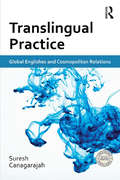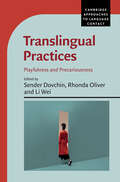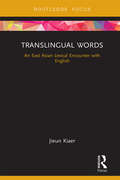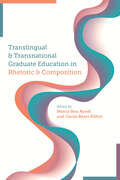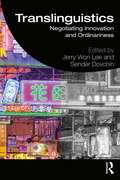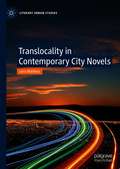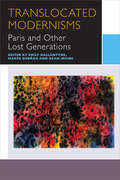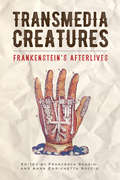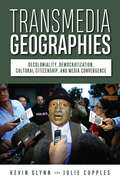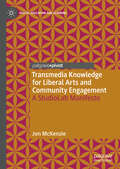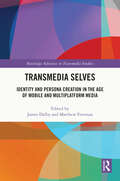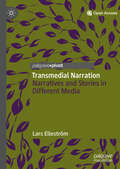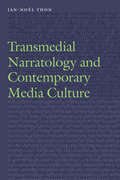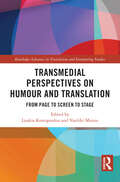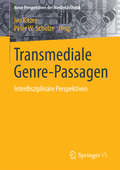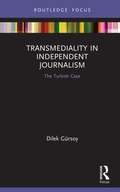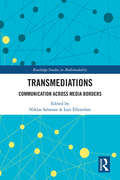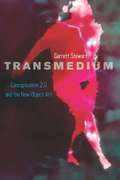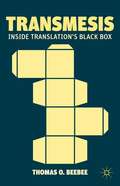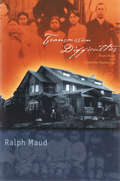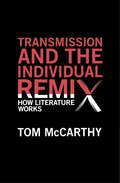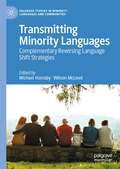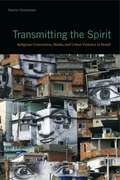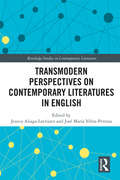- Table View
- List View
Translingual Practice: Global Englishes and Cosmopolitan Relations
by Suresh CanagarajahWinner of the AAAL Book Award 2015Winner of the Modern Language Association's Thirty-Third Mina P. Shaughnessy Prize Winner of the BAAL Book Prize 2014 Translingual Practice: Global Englishes and Cosmopolitan Relations introduces a new way of looking at the use of English within a global context. Challenging traditional approaches in second language acquisition and English language teaching, this book incorporates recent advances in multilingual studies, sociolinguistics, and new literacy studies to articulate a new perspective on this area. Canagarajah argues that multilinguals merge their own languages and values into English, which opens up various negotiation strategies that help them decode other unique varieties of English and construct new norms. Incisive and groundbreaking, this will be essential reading for anyone interested in multilingualism, world Englishes and intercultural communication.
Translingual Practices: Playfulness and Precariousness (Cambridge Approaches to Language Contact)
by Li Wei Sender Dovchin Rhonda OliverBringing together work from a team of international scholars, this groundbreaking book explores how language users employ translingualism playfully, while, at the same time, negotiating precarious situations, such as the breaking of social norms and subverting sociolinguistic boundaries. It includes a range of ethnographic studies from around the globe, to provide us with insights into the everyday lives of language users and learners and their lived experiences, and how these interact in translingual practices. A number of mixed methodological frameworks are included to study language users' behaviours, experiences and actions, cover the complexity of language evolutionary processes, and ultimately show that precarity is as fundamental to translingualism as playfulness. It points to a future research direction in which research should be pragmatically applied into real pedagogical actions by revealing the sociolinguistic realities of translingual users, fundamentally addressing broader issues of racism, social injustice, language activism and other human rights issues.
Translingual Words: An East Asian Lexical Encounter with English
by Jieun KiaerTranslingual Words is a detailed case study on lexical integration, or mediation, occurring between East Asian languages and English(es). In Part I, specific examples from global linguistic corpora are used to discuss the issues involved in lexical interaction between East Asia and the English-speaking world. Part II explores the spread of East Asian words in English, while Part III discusses English words which can be found in East Asian languages. Translingual Words presents a novel approach on hybrid words by challenging the orthodox ideas on lexical borrowing and explaining the dynamic growth of new words based on translingualism and transculturalism.
Translingual and Transnational Graduate Education in Rhetoric and Composition
by Nancy Bou Ayash Carrie Byars KilfoilTranslingual and Transnational Graduate Education in Rhetoric and Composition investigates the implications of composition studies’ changing terminological and ideological landscape around language and nation for the professionalization of future university writing teacher-scholars. As the collection editors argue, incorporating translingual and transnational theories into graduate pedagogy and curricular structures is necessary if they are to shape professional practices in rhetoric and composition long term. Contributors to the collection articulate the need for translingual and transnational sensibilities in rhetoric and composition graduate programs in light of the material conditions of graduate students’ lives and labor. They further present pathways for rethinking the design of graduate-level coursework, foreign language learning policies and labor, mentoring practices, writing teacher and writing center tutor training, and other professionalization initiatives. Offering a range of conceptually and empirically driven pieces, the collection brings together the voices and lived experiences of graduate students, faculty advisors, and administrators involved in the constant, necessary reworking of rhetoric and composition graduate education in a variety of institutional locales. Translingual and Transnational Graduate Education in Rhetoric and Composition provides inspiration for graduate programs working to enact well-grounded curricular and pedagogical changes to counter the long-standing effects of the dominant racist and monolingualist ideologies in higher education generally, and rhetoric and composition studies specifically. Contributors: Lucía Durá, Patricia Flores, Joe Franklin, Moisés Garcia-Renteria, Bruce Horner, Aimee Jones, Corina Lerma, Kate Mangelsdorf, Brice Nordquist, Madelyn Pawlowski, Christine Tardy, Amy Wan, Alex Way, Anselma Widha Prihandita, Joe Wilson, Xiaoye You, Emily Yuko Cousins, Michelle Zaleski
Translinguistics: Negotiating Innovation and Ordinariness
by Jerry Won Lee Sender DovchinTranslinguistics represents a powerful alternative to conventional paradigms of language such as bilingualism and code-switching, which assume the compartmentalization of different 'languages' into fixed and arbitrary boundaries. Translinguistics more accurately reflects the fluid use of linguistic and semiotic resources in diverse communities. This ground-breaking volume showcases work from leading as well as emerging scholars in sociolinguistics and other language-oriented disciplines and collectively explores and aims to reconcile the distinction between 'innovation' and 'ordinariness' in translinguistics. Features of this book include: 18 chapters from 28 scholars, representing a range of academic disciplines and institutions from 11 countries around the world; research on understudied communities and geographic contexts, including those of Latin America, South Asia, and Central Asia; several chapters devoted to the diversity of communication in digital contexts. Edited by two of the most innovative scholars in the field, Translinguistics: Negotiating Innovation and Ordinariness is essential reading for scholars and students interested in the question of multilingualism across a variety of subject areas.
Translocality in Contemporary City Novels (Literary Urban Studies)
by Lena MattheisTranslocality in Contemporary City Novels responds to the fact that twenty-first-century Anglophone novels are increasingly characterised by translocality—the layering and blending of two or more distant settings. Considering translocal and transcultural writing as a global phenomenon, this book draws on multidisciplinary research, from globalisation theory to the study of narratives to urban studies, to explore a corpus of thirty-two novels—by authors such as Chimamanda Ngozi Adichie, Dionne Brand, Kiran Desai, and Xiaolu Guo—set in a total of ninety-seven cities. Lena Mattheis examines six of the most common strategies used in contemporary urban fiction to make translocal experiences of the world narratable and turn them into relatable stories: simultaneity, palimpsests, mapping, scaling, non-places, and haunting. Combining and developing further theories, approaches, and techniques from a variety of research fields—including narratology, human geography, transculturality, diaspora spaces, and postcolonial perspectives—Mattheis develops a set of cross-disciplinary techniques in literary urban studies.
Translocated Modernisms: Paris and Other Lost Generations (Canadian Literature Collection)
by Emily Ballantyne, Marta Dvořák & Dean IrvineTranslocated Modernisms is a collection of ten chapters partitioned into sections and framed by an introduction by the editors and a coda by Kit Dobson, which is interested in those who thronged to the vibrant streets, cafés, and salons of Montparnasse, those who stayed such as Brion Gysin and Mavis Gallant, those who returned “home” such as Morley Callaghan, John Glassco, David Silverberg, and Sheila Watson, and those who galvanized local cultural practices by appropriating and translating them from elsewhere. While for some Paris becomes a permanent home, for others, it is simply a temporary excursion which can last for months, or for many years. The collection opens up the Lost Generation to include multiple generations and broadens its ambit to encompass modernist writers placed under erasure by dominant narratives of Anglo-American modernism. Instead of limiting the category to a single group based on a collective identity, this volume considers lost generations as a particular type of modernist identity attributable to multiple and disparate collectivities. These lost generations include those excluded from canonical narrativizations of expatriate modernisms, among which we spy the glimmer of other modernists living in the shadows of luminaries long recognized in the Anglo-American tradition.
Transmedia Creatures: Frankenstein’s Afterlives
by Claire Nally Diego Saglia Ruth Heholt Andrew McInnes Lidia De Michelis Eleanor Beal Gino Roncaglia Claudia Gualtieri Federico Meschini Enrico Reggiani Daniele Pio Buenza Janet LarsonOn the 200th anniversary of the first edition of Mary Shelley’s Frankenstein, Transmedia Creatures presents studies of Frankenstein by international scholars from converging disciplines such as humanities, musicology, film studies, television studies, English and digital humanities. These innovative contributions investigate the afterlives of a novel taught in a disparate array of courses - Frankenstein disturbs and transcends boundaries, be they political, ethical, theological, aesthetic, and not least of media, ensuring its vibrant presence in contemporary popular culture. Transmedia Creatures highlights how cultural content is redistributed through multiple media, forms and modes of production (including user-generated ones from “below”) that often appear synchronously and dismantle and renew established readings of the text, while at the same time incorporating and revitalizing aspects that have always been central to it. The authors engage with concepts, value systems and aesthetic-moral categories—among them the family, horror, monstrosity, diversity, education, risk, technology, the body—from a variety of contemporary approaches and highly original perspectives, which yields new connections. Ultimately, Frankenstein, as evidenced by this collection, is paradoxically enriched by the heteroglossia of preconceptions, misreadings, and overreadings that attend it, and that reveal the complex interweaving of perceptions and responses it generates. Published by Bucknell University Press. Distributed worldwide by Rutgers University Press.
Transmedia Geographies: Decoloniality, Democratization, Cultural Citizenship, and Media Convergence
by Julie Cupples Kevin GlynnLooking at the US, New Zealand, and Central America, this book considers how cultural politics has been deeply reworked in our contemporary media environment. The authors analyze how rampant technological convergence has allowed stories to spill across media platforms as well as geographical borders and how those stories reemerge as transmediated events. The authors explore the cultural politics that have developed within this new media environment by moving across the mediated landscapes of the first, third, and fourth (Indigenous people’s) worlds, which are deeply intertwined and interconnected under contemporary conditions of neoliberal globalization and emergent regimes of authoritarian postdemocracy. The book attends both to the platforms and digital networks of the new media environment and to the cultural forms and practices that have constituted television as the dominant medium of communication throughout the second half of the twentieth century. In the new media environment, transmediation works on behalf not only of those corporate megaconglomerates that have become all too familiar to media consumers around the world but also of many communities that have previously been excluded from access to the means of electronic textual production and circulation. For the latter, grassroots transmediation has become an important technique for the production of cultural citizenship.
Transmedia Knowledge for Liberal Arts and Community Engagement: A StudioLab Manifesto (Digital Education and Learning)
by Jon McKenzieThis book sets forth a pedagogy for renewing the liberal arts by combining critical thinking, media activism, and design thinking. Using the StudioLab approach, the author seeks to democratize the social and technical practices of digital culture just as nineteenth century education sought to democratize literacy. This production of transmedia knowledge—from texts and videos to comics and installations—moves students between seminar, studio, lab, and field activities. The book also wrestles with the figure of Plato and the very medium of knowledge to re-envision higher education in contemporary societies, issuing a call for community engagement as a form of collective thought-action.
Transmedia Selves: Identity and Persona Creation in the Age of Mobile and Multiplatform Media (Routledge Advances in Transmedia Studies)
by Matthew Freeman James DalbyThis book examines the mediated shift in the contemporary human condition, focusing on the ways in which we synthesise with media content in daily life, essentially transmediating ourselves into new forms and (re)creating ourselves across media. Across an international roster of essays, this book establishes a transdisciplinary theory for the ‘transmedia self’, exploring how technological ubiquity and digital self-determination combine with themes and disciplines such as celebrity culture, fandom, play, politics, and ultimately broader self-conception and projection to inform the creation of transmedia identities in the twenty-first century. Specifically, the book repositions transmediality as key to understanding the formation of identity in a post-digital media culture and transmedia age, where our lives are interlaced, intermingled, and narrativised across a range of media platforms and interfaces. This book is ideal for scholars and students interested in transmedia storytelling, cultural studies, media studies, sociology, philosophy, and politics.
Transmedial Narration
by Lars ElleströmThis open access book is a methodical treatise on narration in different types of media. A theoretical rather than a historical study, Transmedial Narration is relevant for an understanding of narration in all times, including our own. By reconstructing the theoretical framework of transmedial narration, this book enables the inclusion of all kinds of communicative media forms on their own terms.The treatise is divided into three parts. Part I presents established and newly developed concepts that are vital for formulating a nuanced theoretical model of transmedial narration. Part II investigates the specific transmedial media characteristics that are most central for realizing narratives in a plenitude of different media types. Finally, Part III contains brief studies in which the narrative potentials of painting, instrumental music, mathematical equations, and guided tours are illuminated with the aid of the theoretical framework developed throughout the book. Suitable for advanced students and scholars, this book provides tools to disentangle the narrative potential of any form of communication.
Transmedial Narratology and Contemporary Media Culture (Frontiers of Narrative)
by Jan-Noël ThonNarratives are everywhere—and since a significant part of contemporary media culture is defined by narrative forms, media studies need a genuinely transmedial narratology. Against this background, Transmedial Narratology and Contemporary Media Culture focuses on the intersubjective construction of storyworlds as well as on prototypical forms of narratorial and subjective representation. It provides not only a method for the analysis of salient transmedial strategies of narrative representation in contemporary films, comics, and video games but also a theoretical frame within which medium-specific approaches from literary and film narratology, from comics studies and game studies, and from various other strands of media and cultural studies may be applied to further our understanding of narratives across media.
Transmedial Perspectives on Humour and Translation: From Page to Screen to Stage (Routledge Advances in Translation and Interpreting Studies)
by Loukia Kostopoulou and Vasiliki MisiouThis innovative collection spotlights the role of media crossovers in humour translation and how the latter is conveyed through new means of communication. The volume offers an in-depth exploration of the entanglements of film, theatre, literature, TV, the Internet, etc., within the framework of transmediality and their influence on the practice of translating humour. Chapters focus on the complex web of interrelationships shaped by and shaping the process(es) of transformation and adaptation that take place across media and across languages and cultures. Situating translation practices and innovations within an interdisciplinary context, the volume underscores the hybrid nature and complex semiotics of humour and the plurality of possibilities for new insights that contemporary approaches offer driven by technological advancements in the industry. The book will be of particular interest to scholars and researchers in the fields of Translation Studies, Humour Studies, Audiovisual Translation, Media Studies, and Adaptation Studies.
Transmediale Genre-Passagen
by Ivo Ritzer Peter W. SchulzeGenres unterliegen stets Transformationsprozessen und stehen in Wechselbeziehungen zu anderen Genres - nicht nur intramedial, sondern in einer medienpluralisierten globalen Gesellschaft immer stärker auch medienübergreifend. Daher lassen sich anhand generischer Strukturen auch komplexe mediale und kulturelle Austauschprozesse beobachten und analysieren. Dieser Band fokussiert transmediale Erscheinungen und bietet eine interdisziplinäre Plattform, um verschiedene Forschungsperspektiven miteinander zu verbinden, die sich in Bezug auf Genre-Muster in differenten Medien traditionell eher isoliert entwickelt und auch unterschiedlich konzipierte Terminologien hervorgebracht haben.
Transmediality in Independent Journalism: The Turkish Case (Routledge Advances in Transmedia Studies)
by Dilek GürsoyTransmediality in Independent Journalism investigates mainstream journalism and its escape routes to independence through transmedia strategies. Within the scope of the latest debates in Turkey, the author argues that the function of transmediality in Turkish journalism is gradually shifting from being only a commercial entity to becoming a political system for social change, a survival mechanism for independent journalists to reach out to diverse audiences, and gain back the public trust. Bringing a fresh perspective to recent studies on cultures of transmediality along with an in-depth analysis of three contemporary Turkish cases, the book: Builds upon questions of whether transmedia storytelling can offer a support system to construct an alternative news media world in a political context such as Turkey’s Examines how transmedia storytelling can reach places the mainstream news media can’t control Explores whether transmedia storytelling can sustain the survival of an independent journalist in Turkey’s political context Looking beyond the case of Turkey, this study will be an important addition to the literature on rethinking journalistic form and practice, teaching transmedia strategies, and social communication. It will be of great benefit to students and scholars of journalism studies, transmedia studies, and media and communication studies.
Transmediations: Communication Across Media Borders (Routledge Studies in Multimodality)
by Lars Elleström Niklas SalmoseThis collection offers a multi-faceted exploration of transmediations, the processes of transfer and transformation that occur when communicative acts in one medium are mediated again through another. While previous research has explored these processes from a broader perspective, Salmose and Elleström argue that a better understanding is needed of the extent to which the outcomes of communicative acts are modified when transferred across multimodal media toward fostering a better understanding of our knowledge of communication more generally. Building on this imperative as a point of departure, the book details a variety of transmediations, viewed through three different lenses. The first part of the volume looks at narrative transmediations, building on existing work done by Marie-Laure Ryan on transmedia storytelling. The second section focuses less on narratological instances and more on the spatial dynamics of transmediation and the role of embodiment in the process. The final third of the book explores the challenges of transmediating scientific data into narrative format in the context of environmental issues. Taken together, these sections highlight a range of case studies of transmediations and in turn, the complexity and variety of the process, informed by the different methodologies of the different disciplines to which these transmediations belong. This innovative volume will be of particular interest to students and scholars in multimodality, communication, intermediality, semiotics, and adaptation studies.
Transmedium: Conceptualism 2.0 and the New Object Art
by Garrett StewartIf you attend a contemporary art exhibition today, you’re unlikely to see much traditional painting or sculpture. Indeed, artists today are preoccupied with what happens when you leave behind assumptions about particular media—such as painting, or woodcuts—and instead focus on collisions between them, and the new forms and ideas that those collisions generate. Garrett Stewart in Transmedium dubs this new approach Conceptualism 2.0, an allusion in part to the computer images that are so often addressed by these works. A successor to 1960s Conceptualism, which posited that a material medium was unnecessary to the making of art, Conceptualism 2.0 features artworks that are transmedial, that place the aesthetic experience itself deliberately at the boundary between often incommensurable media. The result, Stewart shows, is art whose forced convergences break open new possibilities that are wholly surprising, intellectually enlightening, and often uncanny.
Transmesis
by Thomas O. BeebeeThe concept of transmesis refers to the depiction of translation and translators within fictional texts. The term's metaphorical conjunction of mimesis with translation suggests both the mimetic treatment of items in the black box, i. e. of those aspects of translation that translations as 'finished' products conceal, and also the question of how to represent language and multilingual realities in literature. Thomas O. Beebee examines and compares examples of transmesis across a wide variety of languages, cultures, and historical periods.
Transmission Difficulties
by Ralph MaudIt has been well known since Marius Barbeau's review of the first edition of Franz Boas's Tsimshian Mythology in 1917 that something was seriously amiss with Boas's alleged "translations" of the stories gathered by his chief Tsimshian informant, Henry Tate. But what, exactly, was it that Boas was doing with Tate's stories? Ralph Maud answers this question in Transmission Difficulties.
Transmission Difficulties: Franz Boas and Tsimshian Mythology
by Ralph MaudIt has been well known since Marius Barbeau's review of the first edition of Franz Boas's Tsimshian Mythology in 1917, that something was seriously amiss with Boas's alleged "translations" of the stories gathered by his chief Tsimshian informant, Henry Tate. But what, exactly, was it that Boas was doing with Tate's stories? It is this question that Ralph Maud sets out to address in Transmission Difficulties. * Boas's original misrepresentations of the over 2,000 pages of material he received from Henry Tate have been denied by the ethnographic establishment for over eighty years. His distortion of Tate's stories has been rationalized, to date, as "cultural relativism"--any loss of Tate's original material in this ethnographic "collaboration" between Native informant and European scientist was "unavoidable," due to the presumably equal "cultural differences" between them. This, Maud argues convincingly, is not the case at all. The fact that Boas paid Tate for his stories by the page, and furthermore instructed Tate specifically on what stories, and even on what kinds of stories he was to gather and submit, created a profoundly unequal relationship between these two men, which resulted in an inevitable and pre-determined "authentication" of the Native material by the European ethnographer. * Transmission Difficulties unfolds like a gripping, real-life mystery story. It leaves the reader with a whole new vision of what the relation between European colonials and Aboriginal inhabitants in the Americas might have been, and still might be.
Transmission and the Individual Remix
by Tom MccarthySub-titled "How Literature Works" this essay by the renown novelist is a provocative and entertaining work of postmodern theory that re-evaluates literature and literary meaning from Aeschylus to Kraftwerk. A VINTAGE EBOOK ORIGINAL.Tom McCarthy is one of the most vital young voices in contemporary literature, and in this essay he identifies the signals that have been repeating, pulsing, modulating in the airspace of the novel, poem, play--in their lines, between them and around them--since each of these forms began. Tom takes us back to the Greeks and the origins of literary meaning to show that information, rather than being a natural or abstract phenomenon, is always based in artificial media--in ones and zeros, dots and dashes, signals and noise. He takes us through Ovid, Rilke, Conrad, Joyce, Beckett, and others to re-imagine the very idea of what a writer does, and what the act of writing is. Rather than praising individual creative genius, Tom re-tunes our ears to the crackle of information as it has passed through the feedback loop of literary culture.
Transmitting Minority Languages: Complementary Reversing Language Shift Strategies (Palgrave Studies in Minority Languages and Communities)
by Michael Hornsby Wilson McLeodThis book gives fresh insight into the diverse ways in which the transmission of minority and heritage languages is carried out in a range of sociolinguistic contexts. When traditional modes of intergenerational transmission begin to break down, minority language and diaspora communities resort to other modes of transmission, out of necessity, to complement traditional mechanisms and secure language maintenance. This volume brings together a broad range of studies of these alternative modes of transmission, examining the complex and diverse practical, ideological and personal challenges that arise in different settings. Beyond addressing the dynamics of language use within the home and family, the book also emphasises the importance of the participation of the minority community itself in language and cultural transmission. These mechanisms and initiatives, sometimes overlooked or dismissed in the academic literature, will prove to be essential in maintaining and ensuring the survival of minority and heritage languages into the 21st century and beyond. The twelve chapters in the book are divided into four sections (intergenerational transmission; transmission in post-traditional families; alternatives to ‘traditional’ transmission; and transmission in diasporic contexts), and the language contexts, both minoritised and diasporic, which are discussed include Basque, Breton, Galician, Guernesais, Irish, Māori, Russian, Scottish Gaelic, Sorbian and Spanish. This book will be of interest to students and scholars of sociolinguistics, language acquisition, heritage language maintenance and revitalization, and language policy and planning.
Transmitting the Spirit: Religious Conversion, Media, and Urban Violence in Brazil
by Martijn OosterbaanPentecostalism is one of the most rapidly expanding religious-cultural forms in the world. Its rise in popularity is often attributed to its successfully incorporating native cosmologies in new religious frameworks. This volume probes for more complex explanations to this phenomenon in the favelas of Brazil, once one of the most Catholic nations in the world.Based on a decade of ethnographic fieldwork in Rio de Janeiro and drawing from religious studies, anthropology of religion, and media theory, Transmitting the Spirit argues that the Pentecostal movement’s growth is due directly to its ability to connect politics, entertainment, and religion. Examining religious and secular media—music and magazines, political ads and telenovelas—Martijn Oosterbaan shows how Pentecostal leaders progressively appropriate and recategorize cultural forms according to the religion’s cosmologies. His analysis of the interrelationship among evangélicos distributing doctrine, devotees’ reception and interpretation of nonreligious messaging, perceptions of the self and others by favela dwellers, and the slums of urban Brazil as an entity reveals Pentecostalism’s remarkable capacity to engage with the media influences that shape daily life in economically vulnerable urban areas.An eye-opening look at Pentecostalism, media, society, and culture in the turbulent favelas of Brazil, this book sheds new light on both the evolving role of religion in Latin America and the proliferation of religious ideas and practices in the postmodern world.
Transmodern Perspectives on Contemporary Literatures in English (Routledge Studies in Contemporary Literature)
by Jessica Aliaga-Lavrijsen José María Yebra-PertusaTransmodern Perspectives on Contemporary Literatures in English offers a constructive dialogue on the concept of the transmodern, focusing on the works by very different contemporary authors from all over the world, such as: Chimanda Ngozi Adichie, Margaret Atwood, Sebastian Barry, A. S. Byatt, Tabish Khair, David Mitchell, Alice Munroe, Harry Parker, Caryl Phillips, Richard Rodriguez, Alan Spence, Tim Winton and Kenneth White. The volume offers a thorough questioning of the concept of the transmodern, as well as an informed insight into the future formal and thematic development of literatures in English.
